Positive Health Online
Your Country

Your Body is Being Shaped by Your Shoes
listed in bodywork, originally published in issue 225 - October 2015
Shoes are shaping the humans who wear them - and not for the better. Stiff ankles, tight calves, bunions, and hammer toes. Each of these ailments can be directly linked to what kind of shoes you’ve worn throughout a lifetime.
I deal with the injured public, individuals with head-to-toe ailments that they’ve been trying to remedy for years (and for thousands of dollars) with little or no success. Thwarted by what they put on their feet each morning and stomp around in all day, well-intentioned folks go to the chiropractor’s office, spinal surgeon, and podiatrist looking for answers to the wrong question. The question is not “How can I fix this?” but “What am I doing every day to create this?”
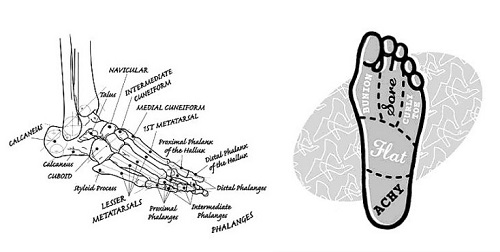
Your shoes and how you use them can limit the full ‘nutritional spectrum’ created through movement. You have thirty-three joints in each foot; the muscle groups of the feet make up twenty-five percent of the body’s total number of muscles. The complex machinery of the feet plays a critical role not only in the obvious realms of gait patterns and ankle stabilization, but also in whole-body balance, nerve conduction, and cardiovascular circulation. Your shoes are affecting a whole lot more than your outfit - they’re capping the limits of your health. That professional footwear you’re selecting each day is the glass ceiling to your well-being.
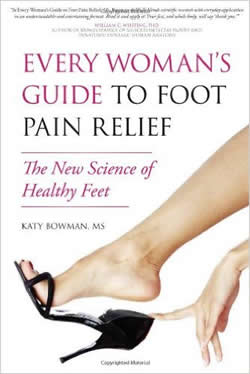
I’ve already written an entire book on the human foot, foot pain, and the effects of shoes (Every Woman’s Guide to Foot Pain Relief: The New Science of Healthy Feet, which is actually every person’s guide to feet). After people read it, the most common question about the footwear guidelines and the shoe recommendations is always something along the lines of “I get what you’re saying about shoes and the feet and alignment in general, but I have specific foot condition X, so what do I need to do, specifically?” Our prescription-oriented medical culture makes us think that we all need a different medicine for our ailments - that what works for most feet will certainly not work for our own because of our special issues. What we don’t understand is that nearly all of these myriad problems are stemming from a cultural problem: there’s a baseline of movement that we are all missing, and our bodies are responding in different ways to the same lack of movement. Once we restore that movement in our lives, our body restores its own equilibrium or homeostasis, eliminating the problems that can seem so unique.
The Problem with Shoes (is not just about shoes or feet)
Imagine you ate a diet crafted entirely out of foods available at a movie theater. Popcorn, soda, candy, and maybe a plate of fake-cheese nachos every now and then. On one hand, in terms of “getting as many calories as you need,” the movie theater diet poses no problem at all. You have food! Amazing. But unless some of that junk food was vitamin C-enhanced, you’d soon find yourself with scurvy. You’d eventually run low on B12; you’d be weak and tired and your digestion would begin to fall apart. You’d become iron-deficient, perhaps developing a swollen and sore tongue or brittle fingernails. Your diet would not include what we now recognize as good (essential) fats. Your pancreas probably couldn’t keep up with your sugar intake. Really, I could craft a list of ailments to go with each missing nutrient as well as a list of ailments that correlate with the excessive consumption of whatever is found in these foods. The list of problems with an all-junk-food diet is equal in length to the nutrients essential to our well-being. Our health is made of the inputs that we both do and don’t get.
If you asked me, “What’s the problem with an all junk-food diet?” the answer could go on forever. But in a nutshell I could say that the input isn’t what your body requires, and that without the correct input, your body will fail over time. On the other hand, given the right context - there is no other food around, for example - you could argue logically (using scientific evidence!) that the movie-theater diet is life-saving.
Similarly, conventional footwear can’t be reduced to one single problem, as each aspect of a shoe does something different to the body. Each shoe feature potentially changes the input created by moving. In some cases, the reduction of input - like a nail or a piece of glass - is welcome. In other cases, the reduction of input - like sensory and motor input to the nerves in the feet, for example - isn’t so good, especially when this reduction has been experienced over a lifetime. Tissues atrophy and die in the absence of input.
In general, conventional footwear is narrower than the foot in its unshod state, has an elevated heel, and is stiff- and thick-soled. Shoes can press the toes together, which weakens foot musculature, thereby affecting nerve health. Elevated heels make it impossible to access the full range of motion of many joints - which in turn creates highly repetitive but small motions in the hips and knees. And because all of your parts are connected, you have to make constant adjustments to the pelvis and spine in order to stay upright while you’re essentially walking downhill (your toes are below your ankles, thanks to your heeled shoes) on flat ground. Don’t get me wrong, adjusting your body to go downhill is no problem - it’s one of the reasons you come with so many hinges. But consider that you’ve been walking on some degree of decline almost every step of your life, which has forced your body to adjust not only its position but its mass distribution and pressure system - all to cope with this ‘heel’ input. See what I mean? Shoes impact the body in many different ways.
The good news is that the very fact that there are so many different problems with shoes actually makes ‘getting healthier’ a bit easier; you can slowly change portions of your body and your shoes over time, which keeps the transition from becoming overwhelming.
When it comes to transitioning out of traditional footwear, everyone needs to begin with a shoe variable that makes sense to their own body. As far as whole-body impact goes, I have found working to eliminate the heel the most important step. However, if you’ve got achy, grippy toes, consider ditching your clogs, mules, or flip-flops (these all require that you clench your toes to keep them on), and find a shoe that has a more attached upper. Maybe you’ve never worn positive-heeled shoes but still have weak feet, or ankles that pronate, and you feel like you need heavy-duty arch support in order for your feet to be comfortable. In that case you’ll benefit greatly from hip and foot strengthening exercises and you’ll probably need to change up the kinds of surfaces you walk on.
I’ve been teaching people about shoes, feet, and gait for over a decade, and I’ve found that understanding the basic geometry of footwear helps people understand the mechanical changes to the body that shoes and walking in shoes over a lifetime can bring about, and why and how the body adapts to different shoe input.
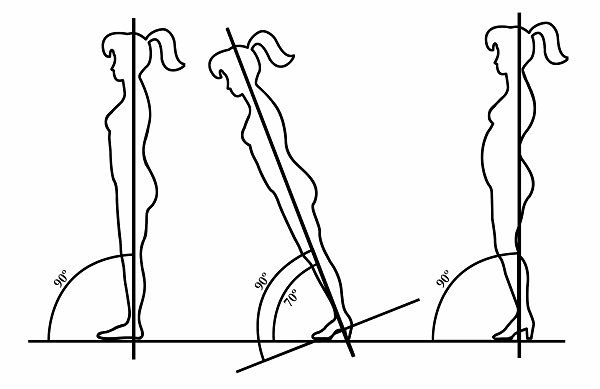
How the Heel Affects Alignment: from Every Woman's Guide To Foot Pain Relief
What is a Heel?
A heel as I’m using the term is any elevation in the back half of a shoe. Many people claim they don’t wear heels, but unless you’ve already been purposefully seeking out completely flat footwear, chances are you’ve been wearing heels. Walk into any shoe store and look at any style of shoe, from ‘flats’ to athletic shoes to sturdy winter boots, never mind the actual ‘heels’, and chances are you’ll find an elevated heel.
Truly, a heel in and of itself is no problem. The body, as I mentioned before, comes with all the equipment necessary (hinges and levers) to adjust to changing gradients underneath the feet. But what about when all of your shoes have been heeled for all of your life?
There are more ‘Parts’ to your Body than you Realize
A healthy body requires healthy cells and in order for your cells to stay healthy they need to be moved. Heeled shoes limit the full use of your joints and thus limit the full movement of all of your parts. Measuring cellular movement is tough, but there are less subtle things going on when you have a heeled shoe, things you can see and measure with your very own eyes: how you walk when you’re wearing them.
In the same way a shoe ‘casts’ the loads to your cells, the heel of a shoe prevents - quite clearly - your heel from reaching the ground. So what? This constant positioning of the heel above the forefoot changes the distances over which our individual parts work. Not the whole body, of course. The whole body still moves over the ground per usual, but how that motion gets done is changed when there is a structure blocking the ankle from participating fully, the way it would if there were no shoe.
When you’re trying to troubleshoot/fix/build a machine, it helps to have a list of components or parts. If I had you name all the parts of the ankle, you could pull out your anatomy book and come up with a list that included tissue-structures like bone, muscle, tendon, and fascia. But if you’re interested in having optimally functioning feet, and restoring the motions that are necessary for muscle development, circulation, and nerve health, your list of components must include the range of motion of the ankle as a ‘part’ of the machine. And just like you’d list all the muscles and bones necessary for facilitating full movement, so then must you list every individual degree of the ankle’s range of motion as its own part.
It might be challenging to consider ‘5 degrees of range of motion’ to be a real part, but keep in mind that as mobility is lost, so is the ultimate function of the machinery of the foot - of any machine, really. Would you accept wheels on your car that only rotated 355°? When you consider every degree of range of motion as ‘necessary’, then you can quickly see why heels don’t work for long-term function. A heel effectively casts a portion of your potential range of motion, keeping this portion from participating when you stand or walk.
Furthermore, each of the muscles we put on our imaginary list of parts isn’t really a single part at all. Each muscle-part is a structure made up of many tiny parts - parts that can be gained or lost through use. And when you lose one joint-range-of-motion part, you also lose one part of your muscle length. Walking with an elevated heel results, over time, in a loss of more parts than you were probably aware of: degrees of motion and lengths of muscle tissue.
This loss of tissue comes with a gain, but it’s not a gain that lends itself to optimal long-term function of the legs. When the heel is prevented access to the ground, all other joints participate more. Again, this isn’t necessarily a bad thing - joints are there to compensate for each other. But this particular compensation, in a natural environment, would be limited to a rise or drop in terrain that would quickly change. Our bodies’ compensations as a whole are not long-term friendly, but are best used as short-term occurrences that are constantly changing with the terrain, in the case of the foot and ankle. Only, we don’t walk on anything but flat ground for most of our steps. And the angle of our shoes is constant. Which means that our body equipment, which performs best in constantly changing conditions, has been given small ranges of motion at a very high frequency. And because every step you’ve ever taken has been using less of the ankle and more than what’s natural of other joints, the muscles and ranges of motion that would have been used (and strengthened) by natural walking have not been, and joints that should not have been used for every step have - and they pay the price.
The effects of this loss/gain relationship don’t just apply to the foot and ankle; the effects are whole-body. Once you start compensating, other joints become limited by proxy, other muscles’ lengths are lost, and so on. And it’s not all loss and shortening; the opposite is true for the opposing areas - imagine the front of the shin of a habitual heel-wearer. When a joint angle is held open for a longer duration than is natural, tissues have to change to accommodate this load. In many cases this brings about unnatural increases in joint laxity (commonly referred to as hypermobility) and in muscle length, which also limit ranges of strong and stabilized motion in a slightly different way.
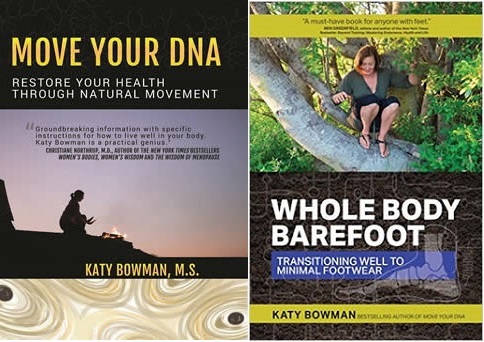
Are there good heels and bad heels? No. There are just heels, no judgment. But every positive heel - even those that have been deemed ‘sensible’ - impedes your body’s full range of motion and affects the literal shape of your body. Which means that even if you work hard to live a movement-filled life of walking, squatting, and hanging (all the essential movements I recommend in Move Your DNA), if you do so wearing conventional running shoes with a half- to one-inch heel, you’re not bringing all of your parts to the party.
Transitioning out of a Heel
So you want to invite some of your old parts back to the party. Does that mean you should throw out your heels straight away? Nope. When you’ve worn a positive-heeled shoe the bulk of your life, your tiny parts are distributed differently than you need them to be in order to walk with your heels down. To transition abruptly is to run the risk of creating an injury. My first recommendation for moving away from a heel is to spend at least a month doing corrective exercises daily while continuing to wear your regular shoes. Yes, even if you regularly wear high heels. Especially if you wear heels every day, all day long. Focus on gradual changes in your shoes. Start working your (heel’s) way down, but do it in stages. There are a number of ‘transitional’ minimal shoes on the market now that offer an 8 millimeter or 4 millimeter heel rise. Slowly lowering the height of your shoes’ heels while at the same time following the exercises laid out in my books are your best bet.
You’ll know you’re ready to progress to a lower heel height when you are able to go deeper with the calf stretch series, when it’s easy for you to keep your pelvis from jutting forward, and when you can walk in lower-heeled shoes without pain.
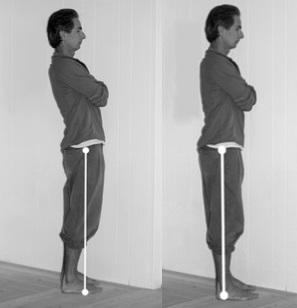
- Back your Hips Up
If you stand sideways to a mirror, and hang a plumb line down from the center of your hip joint, you’ll probably find that the other end is dangling over the front of your foot. The loads created by standing this way are problematic for many reasons, but setting aside things like increased psoas tension, lower-back compression, and reduced weight-bearing status of the hips, it’s also a big problem for your feet. If you find that you do tend to stand with your pelvis out in front of you - a totally normal adaptation to wearing heeled shoes for your entire life - then the bulk of your weight is being carried over the small bones of your feet, instead of being distributed throughout larger, stronger bones in the shins, ankles, and heels. As often as you can throughout the day, back your hips up!
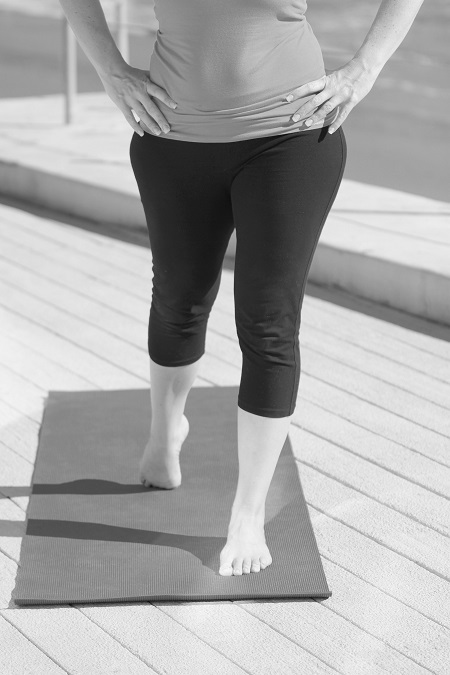
- Top of the Foot Stretch
This stretch is great for undoing chronic “gripping” tension in the toes and the front of the ankle. Holding on to something if necessary, stand on your right foot and reach your left foot back behind you, tucking the toes of your left foot under and placing them on the floor.
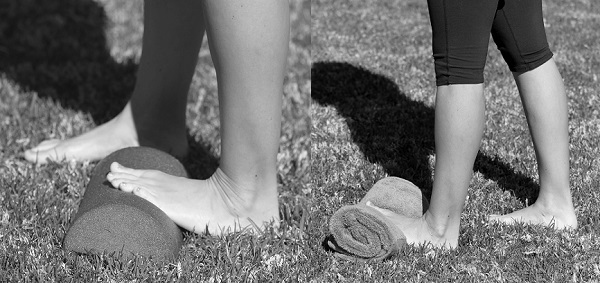
- Calf Stretch
Place the ball of your left foot on the apex of a half-foam roller (I use a 6 x 3 x 12-inch one) or a rolled-up folded towel, drop the heel all the way to the ground, and straighten that knee. Hang out here for a bit, then try to step forward with your right foot.
You should be able to bring your right foot all the way forward, but most people can’t do this immediately. Instead, take a smaller step - your right foot might remain behind your left, or be at the same level, or only a little bit forward. Keep your weight stacked vertically over the heel of whichever foot is farther back.
Comments:
-
No Article Comments available